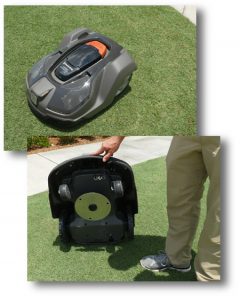New Sod—-scalped by mower
tjg_67 – posted 20 May 2005 21:13 Hi- Looking for advice—New sod installed 2 weeks ago, I ran the mower over the new sod and didn’t realize an uneven area (slope) and inadvertently scalped...
Mowing is the periodic cutting of leaf blades. Turves are mown by mechanical rotary, reel, or flail mowers, or hand scythe. Grass leaf blades elongate from the base thus are adapted to such repetitive defoliation. Most other plants, dicotyledonous (broadleaf) plants especially, do not survive frequent defoliation. Mowing, grazing by animals, and fire act similarly to shift plant communities to domination by grass. To maintain sufficient photosynthetic area, grasses should not be mown more than 1/3 of their vertical height at any cutting. Optimum mowing frequency and height are determined by the 1/3 rule. To conform to this, low height lawns and sporting areas are cut frequently, while taller lawns and rights-of-ways are cut infrequently.
 The reel mower was invented by Edwin Budding in 1830, based on textile finishing machines in the early Industrial Revolution. The reel mower has a cylindrical assembly of spiral steel blades attached to and rotating on a horizontal axis, the “reel.” The rotating blades slice against a fixed bedknife to cut grass leaf blades like scissors. The cut is sharp. In contrast, the rotary mower typically has one or more flattish or beveled blades rotating on a vertical spindle. The rotary mower does not technically cut grass leaf blades but shatters them. As a result of this less efficient action, and aerodynamic propulsion of cut leaf blades or “clippings,” rotary mowers are energetically costly (Fluck and Busey, 1988). Mowers are powered by gasoline, electricity, humans, and animals. There are many adaptations of mowers including hover mowers, filament mowers, and robotic mowers.
The reel mower was invented by Edwin Budding in 1830, based on textile finishing machines in the early Industrial Revolution. The reel mower has a cylindrical assembly of spiral steel blades attached to and rotating on a horizontal axis, the “reel.” The rotating blades slice against a fixed bedknife to cut grass leaf blades like scissors. The cut is sharp. In contrast, the rotary mower typically has one or more flattish or beveled blades rotating on a vertical spindle. The rotary mower does not technically cut grass leaf blades but shatters them. As a result of this less efficient action, and aerodynamic propulsion of cut leaf blades or “clippings,” rotary mowers are energetically costly (Fluck and Busey, 1988). Mowers are powered by gasoline, electricity, humans, and animals. There are many adaptations of mowers including hover mowers, filament mowers, and robotic mowers.
tjg_67 – posted 20 May 2005 21:13 Hi- Looking for advice—New sod installed 2 weeks ago, I ran the mower over the new sod and didn’t realize an uneven area (slope) and inadvertently scalped...
razor – posted 02 May 2005 16:01 Where can i find a side bagger for my 22″ Murray push mower? The model did not come with a bag option when i bought it.
firemansal – posted 24 June 2009 11:10 Howdy yall, I have a tru-cut mower that I have been trying to get sharpened for the last couple of months. I live in Austin Texas and...
SoonerBounce13 – posted 16 March 2009 08:50 I have a tru-cut mower and i was trying to scalp the grass this weekend. However I couldn’t get nearly as low as I wanted due to...
steven123 – posted 18 August 2004 16:05 If I am trying to control weeds(Clover, Bremuda, crab grass in particular) what is the best approach when it comes to mowing, bag or mulch, cut height,...
roswell – posted 13 June 2005 12:36 I am mowing my year-old bermuda lawn the recommened height every 4 days or so. What can I do about the half-circle gouges that my mower creates?...
I almost forgot Do Not over water. Floratan /Seville all strains of St. Augustine are suseptible to fungus from over…
I am from the north and it has taken me five yrs to learn and undertand seville lawns. No 1…
To insert an image into a new post, either first upload it using the "+ New" button in the upper…
To insert an image < 2 MB in size in a comment, below "Leave a Reply" click BROWSE.
How do you post pictures...found link to images, but still unable to post pics.